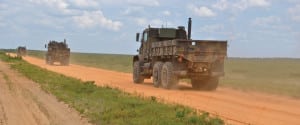
The Army is set to produce the Leader-Follower unmanned driving capability by 2024, Vice Chief of Staff Gen. Daniel Allyn said Thursday.Allyn described Leader-Follower as a system with a pallet loading a fleet of vehicles that provides automated driving for up to four follow-on vehicles for every one manned vehicle. Allyn, talking about Leader-Follower at the Unmanned Systems Defense conference in Arlington, Va., said future unmanned systems must help sustain the force with increased distribution, throughput and efficiency and must…













